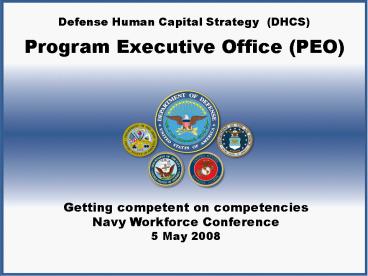Defense Human Capital Strategy DHCS PowerPoint PPT Presentation
1 / 9
Title: Defense Human Capital Strategy DHCS
1
Defense Human Capital Strategy (DHCS)?
Program Executive Office (PEO)?
- Getting competent on competencies
- Navy Workforce Conference
- 5 May 2008
2
Whats new with competencies?
- In the past, we matched workers to jobs
- Checking applicants for education and work
history - Asking and interviewing about personal factors
such as demeanor, cooperative abilities, oral and
written expression, etc. - Now, were asked to select and manage by
competencies - Whats really new here?
- If done right, perhaps a new approach to
matching workers to jobs - Lots of software applications and consultant
services being marketed that expect you to do the
hard part be careful what you buy!
3
Competencies
- Competencies the Knowledge, Skills, Attributes
and Other characteristics (KSAOs) required to
perform a particular job - Thats FIT matching a person to a job
- Competency management is then about defining the
characteristics of the job and then creating a
match to the individual - Two sides requirements v. personnel
- If theres a fit problem there may be several
reasons - The job requirement is wrong
- Selection and/or training is wrong
- The internal management processes are
insufficient to get a match
4
Competency management involves several sequential
steps
5
Job analysis two ways
- In psychology, job analysis means content
validity - This means that individual competencies must be
validated as relevant for the tasks - Established methods exist for ensuring content
validity - Surveys, interviews, observation, empiricism,
etc. - Some more appropriate for certain positions than
others - In management, job analysis means task validity
- This requires process analysis, i.e., checking
that tasks relate to effectiveness and efficiency
in meeting mission requirements - This means application of process reengineering
tools, such as Lean, Six Sigma, Theory of
Constraints, etc. - Competency based workforce management requires
doing both kinds of job analysis
6
Job analysis is the core element of competency
based management
JOB ANALYSIS
CONTENT VALIDITY
TASK VALIDITY
VALIDATED COMPETENCIES
MANPOWER REQUIREMENTS Quantity, quality,
inventory shape, trainers, etc.
PERSONNEL LIFE CYCLE MANAGEMENT Selection,
training, evaluation, career progression,
termination, replacement
- Manpower requirements and personnel life cycle
management are indelible activities that must be
based on a common analytical baseline - There cannot be separate approaches to any of
these steps, they must be grounded on the same
job-analytical foundation
7
Competency management requires competent managers
- Senior managers provide workforce managers with
strategic and mission guidance, but also with the
tools required to perform accomplish stated goals - Generally, PPBS process presumes that the tools
are adequate - But this is not true see Anita Blairs list of
problems this morning - Often, perhaps even most of the time what appears
as a workforce problem is really a deficient
management process - We need to do a serious process analysis of the
entire MPTE structure, from top to bottom, cradle
to grave, incl. the mechanics of PPBS - Workforce management is a local business, but
budget and personnel processes are centrally
controlled and inflexibly applied
8
CBWM in DoD today
- Agencies are focusing on their particular issues
- Navy community based approach, using functional
managers to improve training and personnel
management - Army a broad approach to civilian occupations,
surveying over 100K positions for content
validity of competencies - Air Force one top down approach establishing
common USAF competencies across the board others
inside functional communities (e.g.,
Space/Missile career fields) - DAU survey of inventory turnover and training
gaps (CNA) - DLA survey of some career fields, incl.
contracting (over 65 comps) - ATL/Logistics common dictionary, leading to
better training - Others we will assemble briefings on a common
website for all to see - Whats right each agency focusing on specific
problems - What remains more focus on job analysis, both
kinds
9
so what do we get out of it?
- Depends on what we put into it
- Job analysis focused on tasks is still the heart
of the business essential for defining required
competencies - Tasks must support agency missions and objectives
- Overall, we need more critical analysis of jobs
we lost many people with that essential analytic
knowledge in the drawdown of the 1990s - If a Competency Based system can lead us to
resurrect good manpower requirements analysis
tools, it will leave a permanent contribution - This requires programming action, to ensure that
manpower authorizations, personnel assignments,
and budgetary resources are available

